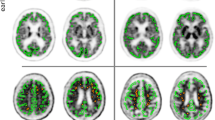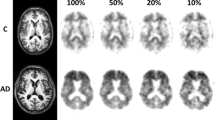Abstract
Objective
This study aims to develop an algorithm named AutoRef to delineate a reference region for quantitative PET amyloid imaging.
Methods
AutoRef sets the reference region automatically using a distinguishing feature in the kinetics of reference region. This is reflected in the shapes of the tissue time activity curve. A statistical shape recognition algorithm of the gaussian mixture model is applied with considering spatial and temporal information on a reference region. We evaluate the BPND with manually set reference region and AutoRef using 86 cases (43 positive cases, 10 equivocal cases, and 33 negative cases) of dynamically scanned 11C-Pittsburgh Compound-B.
Results
From the Bland–Altman plot, the difference between two BPND is 0.099 ± 0.21 as standard deviation, and no significant systematic error is observed between the BPND with AutoRef and with manual definition of a reference region. Although a proportional error is detected, it is smaller than the 95% limits of agreement. Therefore, the proportional error is negligibly small.
Conclusions
AutoRef presents the same performance as the manual definition of the reference region. Further, since AutoRef is more algorithmic than the ordinary manual definition of the reference region, there are few operator-oriented uncertainties in AutoRef. We thus conclude that AutoRef can be applied as an automatic delineating algorithm for the reference region in amyloid imaging.







Similar content being viewed by others
References
Jack CR, Knopman DS, Jagust WJ, Shaw LM, Aisen PS, Weiner MW, et al. Hypothetical model of dynamic biomarkers of the Alzheimer's pathological cascade. Lancet Neurol. 2010;9:119–28.
Julie CP, William EK, Brian JL, Xueling L, Jessica AH, Scott KZ, et al. Kinetic modeling of amyloid binding in humans using PET imaging and Pittsburgh Compound-B. J Cereb Blood Flow Metab. 2005;25:1528–47.
Robert BI, Vincent JC, Jacques D, Fujita M, Albert G, Roger NG, et al. Consensus nomenclature for in vivo imaging of reversibly binding radioligands. J Cereb Blood Flow Metab. 2007;27:1533–9.
Pasha R, Henry E, Anna R, Sergio E, Anders W, Bengt L. An automated method for delineating a reference region using masked volumewise principal-component analysis in 11C-PiB PET. J Nucl Med Technol. 2009;37:38–44.
Geoffrey M, David P. Basic definition. Finite mixture models. New York: Wiley; 2000. p. 6–7.
Kimura Y, Yamada T, Hosokawa C, Okada S, Nagaoka T, Ishii K. Delineation algorithm on reference region for amyloid imaging using a time history of radioactivity: SNMMI 2016 annual meeting. J Nucl Med. 2016;57(2):311.
Yamada T, Kimura Y, Nagaoka T, Hosokawa C, Murakami T, Ishii K. Algorithm for automated delineation of reference regions using the pattern recognition scheme and kinetics of administered tracer—considering number of clustering—11th Human Amyloid Imaging Conference 2017, pp 36–37.
Geoffrey M, David P. Starting values for EM algorithm. Finite mixture models. New York: Wiley; 2000. p. 54–57.
Jean L, Joanna SF, Nora DV, Alfred PW, Stephen LD, David JS, et al. Graphical analysis of reversible radioligand binding from time-activity measurements applied to [N-11C-Methyl]-(-)-cocaine PET studies in human subjects. J Cereb Blood Flow Metab. 1990;10:740–7.
Jean L, Joanna SF, Nora DV, Gene-Jack W, Yu-Shin D, David LA. Distribution volume ratios without blood sampling from graphical analysis of PET data. J Cereb Blood Flow Metab. 1996;16:834–40.
Bart NMB, Rik O, Nelleke T, Maqsood Y, Jessica C, Foster D, Albert DW, et al. Longitudinal amyloid imaging using 11C-PiB: methodologic considerations. J Nucl Med. 2013;54:1570–6.
Hosokawa C, Ishii K, Kimura Y, Hyodo T, Hosono M, Sakaguchi K, et al. Performance of 11C-Pittsburgh Compound B PET binding potential images in the detection of amyloid deposits on equivocal static images. J Nucl Med. 2015;56:1910–5.
Acknowledgements
I express my gratitude to Dr. Chisa Hosokawa for her enthusiastic guidance from the beginning. This work is supported by MEXT KAKENHI Grant No. 15H01131 and Kindai University Research Grants: KD201805 from 2015 to 2017 and KD1804 from 2018.
Author information
Authors and Affiliations
Corresponding author
Ethics declarations
Conflict of interest
No potential conflict of interests was disclosed.
Additional information
Publisher's Note
Springer Nature remains neutral with regard to jurisdictional claims in published maps and institutional affiliations.
Rights and permissions
About this article
Cite this article
Yamada, T., Watanabe, S., Nagaoka, T. et al. Automatic delineation algorithm of reference region for amyloid imaging based on kinetics. Ann Nucl Med 34, 102–107 (2020). https://doi.org/10.1007/s12149-019-01419-9
Received:
Accepted:
Published:
Issue Date:
DOI: https://doi.org/10.1007/s12149-019-01419-9




